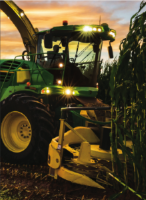Maximizing Corn Silage ROI

The planting season for corn is behind us and most farmers are busy tending to their rows, focused on maximizing yields for the harvest to come. It’s the never ending cycle of agriculture, and it can be an especially touchy science when it comes to silage producers looking for a reasonable ROI.
While there are many factors that go into predicting and reaching these crop yields, here at Mid-State Equipment, we’re going to talk about seed selection as well as chop length and kernel processing. We’ve put together this short guide with some basics that could lead to stronger yields and a better ROI for your corn silage. Read on for more information or head into one of our locations throughout Wisconsin, including our Ag & Turf showroom in Columbus, Wisconsin.
Seed Selection
Finding the right seed or hybrid can make all the difference in the world for maximizing your corn silage yields. This starts with considering soil type in your field. Don’t just go with a hybrid that’s selected for strong agronomics, as they might not be a the best choice for sillage specifically. You want the right seed in the right place! Look for seed that produces soft starch, usually silage-specific, or a dual-purpose hybrid if you’re after good dairy corn silage. Also consider fiber digestibility, which also increases dairy output. Be on the lookout for a balance in agronomics, yield, and forage quality. Soil health and nutrition are also important drivers in forage yield and quality. Just remember that seed selection matters and matching the unique characteristics of a hybrid to your soil can make a huge difference in harvest yields.
Kernel Processing & Chop Length
How kernels are processed can help determine the size of your yield by impacting starch digestion, while chop length impacts particle length needed for rumination. There are few ways to control and ensure quality processing, starting with the right equipment.
Chopper and Roller
The best way to ensure quality processing is to use a chopper in good condition. Make sure your chopper knives and shear bars are in good condition and replace those that aren’t since they prevent even chop lengths. The entire roller mill must be checked for worn-down teeth, as uneven wear might prevent it from performing effectively. Rollers have a hard time with corn in general, so be sure to inspect yours after 400 operating hours. A gap setting of 1 to 2 mm between chopper head and roller mill will crack all the kernels. You’ll also want to set the theoretical length of cut (TLC) to 3/4 inch, longer than typical settings for non-processed corn silage.
Potential Issues
While you shouldn’t have an issue adjusting your harvester to appropriate settings to best process corn for silage, there are a few specific scenarios that could gum up your operation. The grain-to-stover ratio of the crop impacts how much grain goes through the roller mill. A higher grain content ratio means you’ll want a more aggressive processing procedure, which could just mean shortening the TLC. Moisture is also a big issue, with low levels meaning a starchier harvest. Lowering TLC settings may lower effective fiber in dryer corn harvests, but it will be better for packing in the silo. If your roller adjustments don’t produce the expected results for kernel processing, take a look at the differential speed of the roller mill. The upper roller should be running faster than the lower roller, with a differences of 10-15%. Higher or lower ratios should be adjusted accordingly.
Chopper Clinic
The Mid-State Equipment Chopper Clinic is perfect for anyone looking to know more about harvesting with a combine and desires more efficient operations that lead to bigger yields and maximized profits. Learn the best practices for grain quality and profit through harvest optimization. You’ll also get a combine walk around for how to adjust for your crops and field conditions. Add to that a few tips on maintenance for long-lived equipment! And of course learn all the cab controls and best way to utilize monitors. We’ll have you set up for harvest and utilizing everything your combine has to offer! We have clinics scheduled in Janesville, Wisconsin on Thursday, August 9th, and one in Columbus on Thursday, August 16th.
Keeping your harvester in good condition and being thoughtful and thorough in your seed selection can help to maximize your corn silage harvest yield and ROI. Like many aspects of agriculture and agronomics, it’s a open discussion between the farmer and their soil. Different seed and processing parameters might be preferable as you experiment with maximizing yields. No matter your successes or failures, your friends at Mid-State Equipment have your back with a selection of great new and used agricultural equipment. Head into one of our locations throughout Wisconsin, including our Ag & Turf showroom in Columbus, where we’re proud to serve all of Southern Wisconsin. Come in today and let our team of experts answer your questions and help you find what you need.

